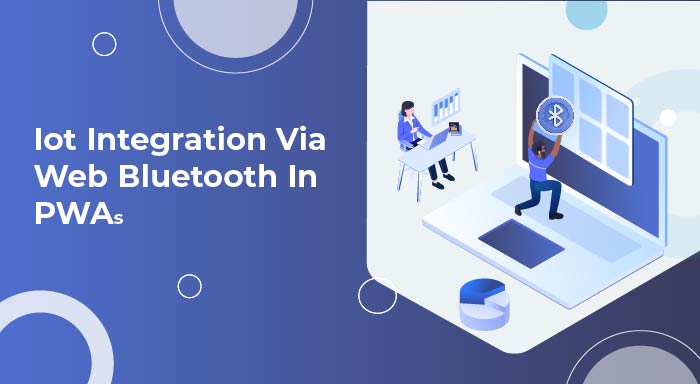Introduction
While choosing the type of application, one has to consider that currently, web technologies are constantly developing and some of its sections have recently introduced Progressive Web Apps that can be used as applications directly through the browser. As more and more devices get connected to the Internet, through IoT technology, developers keep on looking for new approaches to incorporate these IoT smart devices into web applications. That is where Web Bluetooth API comes to the rescue – a tool that is as powerful as it is transformative when it comes to IoT integration into the PWAs.
The Rise of Progressive Web Apps
The concept of Progressive Web Apps has evolved and become popularized over the last couple of years and it essentially creates a blended app-like/full web experience between website and mobile application. PWAs are convenient, performant, and interactive, with offline mode available and push notifications. Their feature to operate on different platforms and yet have a single cod have put them on the top list of developers and businesses.
As PWAs have developed deeper, the user’s requirement for additional features has also increased. One such feature is the user’s interaction with IoT devices which is where web Bluetooth API comes in handy.
Understanding the Web Bluetooth API
The Web Bluetooth API is a JavaScript API that provides a regular Web environment a straight access to BLE devices. This pioneering technology is friendly to IoT devices and makes it easier for PWAs to interconnect with native apps or plugins not required in this type of app.
Key features of the Web Bluetooth API include:
1. Device discovery and connection refers to the act of finding and establishing communication with down-line devices.
2. A new way of reading and writing data to Bluetooth characteristics
3. Notifications that are sent by Bluetooth devices
4. Secure pairing and encryption
These capabilities provide extensive possibilities for the PWA developers seeking to include IoT capability in applications.
Integrating Web Bluetooth API in PWAs
Implementing the Web Bluetooth API in a Progressive Web App involves several steps:
1. Feature Detection:
Before attempting to use the Web Bluetooth API, it's crucial to check if the user's browser supports it. This can be done using a simple JavaScript check:
if ('bluetooth' in navigator) {
// Web Bluetooth API is supported
} else {
// Web Bluetooth API is not supported
}2. Requesting Device Access:
When the user initiates a connection, the app must request access to nearby Bluetooth devices. This is typically done through a user gesture, such as clicking a button:
const device = await navigator.bluetooth.requestDevice({
filters: [{ services: ['battery_service'] }]
});3. Connecting to the Device:
Once the user selects a device, the app can establish a connection:
const server = await device.gatt.connect();4. Interacting with the Device:
After connecting, the app can read from or write to the device's characteristics:
const service = await server.getPrimaryService('battery_service');
const characteristic = await service.getCharacteristic('battery_level');
const value = await characteristic.readValue();These examples illustrates the most basic usage of the Web Bluetooth API in PWA. From our findings, developers can use the mentioned fundamentals to enhance interactions with IoT devices.
Use Cases and Applications
The integration of Web Bluetooth API in PWAs opens up numerous possibilities across various industries:
1. Healthcare:
In many cases, the PWAs can link with other health solutions, such as medical devices, enabling patients to manage their health parameters and report various data to healthcare professionals withoutinteropgap.com.
2. Smart Home:
This provides users with a way to manage their smart home devices without using several native applications at all.
3. Fitness and Wearables:
Activity trackers, including smartwatches, can connect with PWAs and allow users to view their current health and activity stats.
4. Industrial IoT:
PWAs can help the maintenance technicians identify and even track the industrial equipment for maintenance schedules, thus cutting short the long hours of procedures.
5. Retail:
The use of beacon technology can help to facilitate and develop in-store experiences for customers and involve them in personalized promotions and novelties.
Challenges and Considerations
While the Web Bluetooth API offers exciting possibilities, developers must also be aware of potential challenges:
1. Browser Support:
While many people have supported Web Bluetooth API, not all the browsers support this API, especially on iOS.
2. Security:
Bluetooth control & data security has to be guaranteed & this is especially important when accessing controls or information & databases.
3. Battery Life:
Bluetooth probe and connection operations can affect the battery life of the device so needs careful integration.
4. User Experience:
Bluetooth access has to be easily discoverable and fairly easy to pair with, that is why developers need to make interfaces for such device connections rather user-friendly because some people may be unaware of how to pair gadgets, for instance, through Bluetooth.
After understanding the concept of PWAs and Web Bluetooth it's time to look into the future of Web Bluetooth in PWAs.
With time, owing to the emerging support of modern browsers, and future adoption by more developers, we are likely to witness gradually more and more advanced, distinguishing mobile Progressive Web Apps from the native ones.
The Web Bluetooth API is likely to play a crucial role in the future of web development, particularly as the IoT ecosystem continues to expand.
Conclusion
The integration of the Web Bluetooth API into Progressive Web Apps represents a significant leap forward in web technology. By enabling direct communication between web applications and IoT devices, developers can create more powerful, versatile, and user-friendly experiences. As the technology matures and browser support improves, we can expect to see an explosion of innovative PWAs that seamlessly integrate with the growing world of connected devices.
For businesses looking to leverage this technology, it's important to partner with experienced developers who understand both PWA development and IoT integration. While the initial investment in such technologies may seem daunting, the long-term benefits in terms of user engagement and cross-platform compatibility can be substantial. For more information on the costs associated with web development projects, including PWAs, you can refer to this comprehensive guide on https://spdload.com/blog/website-development-cost/.
As we move towards an increasingly connected future, the combination of Progressive Web Apps and the Web Bluetooth API stands poised to revolutionize how we interact with the digital and physical worlds around us. Developers and businesses that embrace this technology early will be well-positioned to lead the charge in the next generation of web applications.



